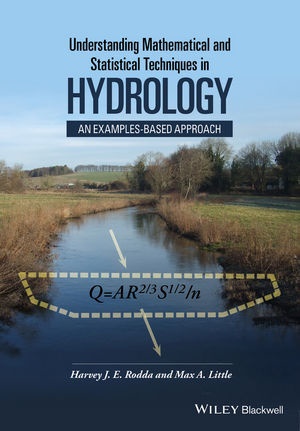Read more
Informationen zum Autor Dr Harvey J. E. Rodda graduated in Environmental Science from Lancaster University and completed his PhD in the Department of Geography, Exeter University in 1993 in the field of hydrological modelling. He is currently a director of Hydro-GIS Ltd, a consultancy company providing specialist services in hydrology and GIS mostly within the private sector. Since 2005 he has been a visiting lecturer at University College London, Department of Earth Sciences, teaching a hydrology module as part of the Geophysical Hazards MSc course. Professor Max A. Little began his career writing software, signal processing algorithms and music for video games, then moved on by way of a degree in mathematics to the University of Oxford. After postdoc positions in Oxford investigating rainfall and biophysical time series data, he won a Wellcome Trust fellowship at MIT to follow up on his doctoral research work in behavioural and biomedical signal processing. He is currently an associate professor of mathematics at Aston University and a visiting professor at MIT's Media Lab. Klappentext Pick up any hydrology textbook and it will not be long before you encounter pages listing sequences of equations representing complex mathematical concepts. Students and practitioners of hydrology will not find this very helpful, as their aim, generally, is to study and understand hydrology, and not to find themselves confronted with material that even students of mathematics would find challenging. Often, equations appear to be copied and pasted into hydrological texts in an attempt to give a more rigorous scientific basis to the narrative. However, they are commonly wrong, poorly explained, without context or background, and more likely to confuse and distance the reader than to enlighten and engage them in the topic.Understanding Mathematical and Statistical Techniques in Hydrology provides full and detailed expositions of such equations and mathematical concepts, commonly used in hydrology. In contrast to other hydrological texts, instead of presenting abstract mathematical hydrology, the essential mathematics is explained with the help of real-world hydrological examples. Zusammenfassung Pick up any hydrology textbook and it will not be long before you encounter pages listing sequences of equations representing complex mathematical concepts. Inhaltsverzeichnis Preface vii How to use this book x 1 Fundamentals 1 1.1 Motivation for this book 1 1.2 Mathematical preliminaries 2 2 Statistical modelling 19 2.1 The Central European Floods, August 2002 19 2.2 Extreme value analysis 22 2.3 Simple methods of return period estimation 22 2.4 Return periods based on distribution fitting 25 2.5 Techniques for parameter estimation 30 2.6 Bayesian parameter estimation 30 2.7 Resampling methods: bootstrapping 31 3 Mathematics of hydrological processes 34 3.1 Introduction 34 3.2 Algebraic and difference equation methods 34 3.3 Methods involving exponentiation 36 3.4 Rearranging model equations 36 3.5 Equations with iterated summations and products 38 3.6 Methods involving differential equations 41 3.7 Methods involving integrals 43 4 Techniques based on data fitting 45 4.1 Experimental and observed data 45 4.2 Rating curves 46 4.3 Regression with two or more independent variables 49 4.4 Demonstration of decaying quantities 51 4.5 Analysis based on harmonic functions 52 5 Time series data 55 5.1 Introduction 55 5.2 Characteristics of time series data 55 5.3 Testing for time dependence 57 5.4 Testing for trends 58 5.5 Frequency analysis 59 5.6 Other analysis methods 60 5.7 Smoothing and filtering 60 5.8 Linear smooth...
List of contents
Preface vii
How to use this book x
1 Fundamentals 1
1.1 Motivation for this book 1
1.2 Mathematical preliminaries 2
2 Statistical modelling 19
2.1 The Central European Floods, August 2002 19
2.2 Extreme value analysis 22
2.3 Simple methods of return period estimation 22
2.4 Return periods based on distribution fitting 25
2.5 Techniques for parameter estimation 30
2.6 Bayesian parameter estimation 30
2.7 Resampling methods: bootstrapping 31
3 Mathematics of hydrological processes 34
3.1 Introduction 34
3.2 Algebraic and difference equation methods 34
3.3 Methods involving exponentiation 36
3.4 Rearranging model equations 36
3.5 Equations with iterated summations and products 38
3.6 Methods involving differential equations 41
3.7 Methods involving integrals 43
4 Techniques based on data fitting 45
4.1 Experimental and observed data 45
4.2 Rating curves 46
4.3 Regression with two or more independent variables 49
4.4 Demonstration of decaying quantities 51
4.5 Analysis based on harmonic functions 52
5 Time series data 55
5.1 Introduction 55
5.2 Characteristics of time series data 55
5.3 Testing for time dependence 57
5.4 Testing for trends 58
5.5 Frequency analysis 59
5.6 Other analysis methods 60
5.7 Smoothing and filtering 60
5.8 Linear smoothing and filtering methods 61
5.9 Nonlinear filtering methods 64
5.10 Time series modelling 66
5.11 Hybrid time series/process-based models 67
5.12 Detecting non-stationarity 69
6 Measures of model performance, uncertainty and stochastic modelling 71
6.1 Introduction 71
6.2 Quantitative measures of performance 71
6.3 Comparing measures 73
6.4 The Nash-Sutcliffe method 75
6.5 Stochastic modelling 76
6.6 Monte Carlo simulations 77
6.7 Non-uniform Monte Carlo sampling 79
6.8 Uncertainty in hydrological modelling 81
6.9 Uncertainty in combined models 82
6.10 Assessing uncertainty given observed data: Bayesian methods 83
Glossary 86
Index 8

